jeff9366
Super Star Member
- Joined
- Jan 14, 2011
- Messages
- 12,394
- Tractor
- Kubota Tractor Loader L3560 HST+ ~~~~~~~~~~~~~ 3,700 pounds bare tractor, 5,400 pounds operating weight, 37 horsepower
DISC HARROW SELECTION For 18-45-hp Tractors
Disc Harrows come in numerous types. However, for 18-45 horsepower tractors the secondary tillage, three point hitch mounted, Tandem Disc Harrow is ubiquitous. Tandem Disc Harrows are manufactured in two structural types: Angle Iron Frame and Box Frame. The Box Frame Disc Harrow is stronger, heavier, has greater adjustability of the gang angles and is less prone to working loose than an Angle-Iron Frame Disc Harrow. If the budget allows, purchase a Box Frame Disc Harrow.
February 28, 2013 I took delivery of a Howse, box-frame, 3-Pt. disc harrow, Model DLHT16822B, from my local Kubota/Howse dealer. The dealer, from who I bought my tractor, recommended I consider the Howse DLHT. At the time I was researching Land Pride, Everything Attachments (ETA), TSC/Countyline and Monroe Tufline.
Howse DLHT is a three point hitch mounted, box-frame 16/18 disc harrow, meaning 16 notched discs, each 18" in diameter, discs spaced 9-1/2" apart. It cuts a swath nominally 5'-6" in width, adjustable by sliding the disc hangers in or out. Howse, Land Pride, ETA and Tufline box frame discs referenced in this post are spec'd as 16/18, 5 to 5'-6" wide for consistency. Most manufactures also offer a 20/18 option, which has discs spaced 7-1/2" apart.
Howse describes the DLHT series as MEDIUM DUTY. The Howse DLHT16822B weighs 587 pounds. It has a 1" axle on sealed flange bearings. I paid $950 delivered. (No sales tax in Florida on ag or forestry equipment.)
( Howse also sells DHT Series disc harrows with 20" discs and 1-1/8" axles, which Howse describes as HEAVY DUTY. )
Default Howse configuration is 16/18. My primary objective involves CUTTING, opening new game feed plots, maintaining vegetation free fire breaks and renovating pasture, not smoothing plow furrows. The harrow weight on 16 discs, rather than 20 discs, puts more cutting weight on each disc. (There is a T-B-N consensus that to cut vegetation Disc Harrows should have 40+ pounds weighting each disc. My Howse has 37 pounds weighting each disc.)
Tractor users with SMOOTHING (plow furrows) as their priority will want to consider the 20/18 (7-1/2" between discs) or 20/20 configuration.
Disc harrows come with two types of discs: notched and smooth. Notched discs cut pasture grass and crop stubble better; in open soil notched blades jerk out trash, meaning vines and tree roots, which often stick in the notches. If you have a load of rocks in your soil, bear in mind notched discs deform easier than solid/smooth discs. The Howse DLHT ships with notched discs front and rear, good for my conditions and objectives.
Discs for compact tractor harrows come in 16"-18"-20" diameter. Generally speaking sub-compact tractors will use 16" diameter discs, mid-size compacts 18" discs; 40+ horsepower utility tractors may opt for 20".
The issues with diameter are concavity, wear, harrow weight and clearance lift. Smaller diameter discs generally have less concavity (less "float") than larger discs, so they cut easier; smaller discs are thinner than larger diameter discs. Larger diameter discs generally have greater concavity, so move more soil laterally. Larger diameter, thicker discs will wear longer before needing replacement. Thicker discs, if notched, may be less prone to deform in rocky soil. Larger diameter, thicker discs add to harrow weight, which offsets "float" to some degree.
Replacement 18 inch discs are available in 3mm, 3.5mm, and 4mm thickness. Replacement 20 discs are available in 3.5mm, 4mm, 4.5mm, 4.76mm, 5mm and 6.35mm thickness. As you see, diameters and thickness overlap. Thicker discs are heavier. (Agri-Supply offers ***516*** replacement disc types on its web site. (What a great country!)
Discs of larger diameter require more lift from the three point hitch. Clearance can be an issue when crossing ditches, rough ground and loading or unloading a tractor mounted Disc Harrow from a trailer.
The Howse has a dropped double clevis (Photo #11) to receive draw pins. On a Disc Harrow for a compact tractor a dropped clevis is nice; it allows the 3-Pt. to lift the harrow sooner. Note pictures showing harrow in the air. Minimum disc height above ground is 14-1/2", greater than 14" ground clearance of my B3300SU. For a larger tractor a dropped clevis would be less relevant.
I prefer a wide double clevis which accepts separate draw pins, over protruding, bolt end "open" draw pins. I believe the double clevis provides a more secure tractor/harrow connection. The TSC Countyline, suitable for a tractor larger than mine, has "open" draw pins protruding from the harrow frame; in a "normal", undropped position. The Land Pride DH1560 has dropped "open" draw pins. Wider Land Pride Disc Harrows have double clevis standard.
The Howse, with its 3" wide, dropped, double clevis is the easiest implement I own to mount on the three point hitch.
The local Tractor Supply Company (TSC) sells a seven foot wide, box frame 20/18 Countyline disc, manufactured by Tarter, of similar design to the Howse, as HEAVY DUTY. (TSC/Tarter disc in three photos is 7' width.) Clamp plate gang angle adjustment shared by the Howse and TSC/Tarter is common to 90% of box frame Disc Harrows.
The Howse and TSC Countyline/Tarter harrows have same clamp plate retention of gang adjustments, but the Howse has five adjustment holes per gang, the TSC four holes per gang. Both have three through bolts/nuts clamping upper and lower adjustment plates, which have two rib guides on the top plate mirrored by two rib guides on the bottom plate. To adjust the gang angles, the two outer bolts/nuts are loosened, the center bolt removed, then the gang is pulled and jiggled to line up holes in sliding adjustment plates with fixed holes in harrow frame, using gang length for leverage. The center bolt is replaced and all three bolts/nuts tightened. {Loosening/replacing bolts/nuts is a fifteen minute process.} I have applied wax lube to the harrow frame over which the adjustment plates slide. New, it adjusts pretty easily. I understand with use, rust, dust, deformity, etc., gang adjustment becomes harder. However, I expect to settle on a 'default' setting soon and only change the gang angles infrequently thereafter.
Some TBN threads suggest substituting a 5" pin as a pivot in lieu of the center bolt. With only a center pin, it seems possible the center support could "jump" the guides; stay with the center bolt and nut.
Relative to the TSC Countyline, the Howse is a slightly simpler/KISS design, its parts more precisely cut, welded and finished.
Two 5' - 6' disc harrows could be accurately described as HEAVY DUTY, by design and by weight. Both adjust gang angles more readily than the Howse/Countyline friction plate system but cost more $$$.
Everything Attachment's ETA-XD-BF-DH-16-18 disc harrow weighs 686 pounds and is priced at $1554 delivered to Fanning Springs, North Florida. The ETA disc has two, long, gang adjustment screws, one on each gang, to adjust the gang angle of attack. I admired ETA disc at the 2012 Sunbelt Ag Expo in Georgia. Leinbach box-frame disc harrows use a functionally identical screw adjustment.
Monroe Tufline's THE71618BF disc harrow (1-1/8" axle) weighs 670 pounds and was quoted at $2100, plus a local delivery charge. The Tufline has lever adjustment of the gang angles. I researched the Tufline 'THE' discs on Tufline's very basic web site. I have not seen a Tufline live but the Tufline brand has an excellent reputation.
Price is not the first priority when I purchase attachments. However, my Florida rock free, sandy-loam is not challenging to disc so I bought the Howse as adequate and a good value.
Pulling a Disc Harrow is high draft force work. Not only is the implement weight being pulled, but the discs are resisting passage through the soil, proportionate to gang angle adjustment. Disc Harrows require minimum five tractor horsepower per foot of width, plus four wheel drive for traction.
I pull the Howse behind a Kubota B3300SU tractor/loader. ( 33-hp / 1,900 pounds / 4-WD / 58" tire width ) Tractor and Howse DLHT disc are a good match. After forty hours pulling the Howse its ground engagement has been completely satisfactory.
The B3300SU is in HST/MED range pulling the Howse. In repeatedly cut soil, in which the Disc Harrow will sink deep, additional throttle is required to keep the B3300SU from bogging down. Infrequently, I need to lift the Harrow just a tad. Draft force can be reduced by adjusting gang angles to a less aggressive setting.
It is important to tighten the four axle nuts regularly on a new disc harrow; they loosen. My Howse vender told me that if the axle nuts are tightened regularly the entire gang assembly settles in eventually and thereafter axle nuts require tightening infrequently. As an experiment I have replaced OEM split ring lock washers on left side with Swedish Nord-Lock anti-vibration lock washers. (See Photo #4) The right side is OEM stock. If axle bolts are not kept tight, disc hubs and axles will work each other, ruining one or both.
A secondary test for tightness involves "ringing" the discs with a mallet when the harrow is elevated. A loose disc will give off a flat tone.
Howse offers its harrows in Kubota orange paint. Thank you, Howse. Standard Howse color is red.
Two complaints: No operator's manual with the Howse. I like manuals. Photo #10: When adjusting the rear gang I found the left clamp bolt to be 4-1/2" long, instead of 5" like the other five clamp/adjusting bolts. Sloppy assembly. So I drove 20 miles/round trip to Tractor Supply for a $3.52, 5" replacement bolt. I have added upper/lower flat washers to six gang angle adjustment bolts to preserve the paint.
HOWSE LINK:
https://store.howseimplement.com/in...en/disc-harrow-16-18-blades-w-ball-brg-1.html
Disc Harrows come in numerous types. However, for 18-45 horsepower tractors the secondary tillage, three point hitch mounted, Tandem Disc Harrow is ubiquitous. Tandem Disc Harrows are manufactured in two structural types: Angle Iron Frame and Box Frame. The Box Frame Disc Harrow is stronger, heavier, has greater adjustability of the gang angles and is less prone to working loose than an Angle-Iron Frame Disc Harrow. If the budget allows, purchase a Box Frame Disc Harrow.
February 28, 2013 I took delivery of a Howse, box-frame, 3-Pt. disc harrow, Model DLHT16822B, from my local Kubota/Howse dealer. The dealer, from who I bought my tractor, recommended I consider the Howse DLHT. At the time I was researching Land Pride, Everything Attachments (ETA), TSC/Countyline and Monroe Tufline.
Howse DLHT is a three point hitch mounted, box-frame 16/18 disc harrow, meaning 16 notched discs, each 18" in diameter, discs spaced 9-1/2" apart. It cuts a swath nominally 5'-6" in width, adjustable by sliding the disc hangers in or out. Howse, Land Pride, ETA and Tufline box frame discs referenced in this post are spec'd as 16/18, 5 to 5'-6" wide for consistency. Most manufactures also offer a 20/18 option, which has discs spaced 7-1/2" apart.
Howse describes the DLHT series as MEDIUM DUTY. The Howse DLHT16822B weighs 587 pounds. It has a 1" axle on sealed flange bearings. I paid $950 delivered. (No sales tax in Florida on ag or forestry equipment.)
( Howse also sells DHT Series disc harrows with 20" discs and 1-1/8" axles, which Howse describes as HEAVY DUTY. )
Default Howse configuration is 16/18. My primary objective involves CUTTING, opening new game feed plots, maintaining vegetation free fire breaks and renovating pasture, not smoothing plow furrows. The harrow weight on 16 discs, rather than 20 discs, puts more cutting weight on each disc. (There is a T-B-N consensus that to cut vegetation Disc Harrows should have 40+ pounds weighting each disc. My Howse has 37 pounds weighting each disc.)
Tractor users with SMOOTHING (plow furrows) as their priority will want to consider the 20/18 (7-1/2" between discs) or 20/20 configuration.
Disc harrows come with two types of discs: notched and smooth. Notched discs cut pasture grass and crop stubble better; in open soil notched blades jerk out trash, meaning vines and tree roots, which often stick in the notches. If you have a load of rocks in your soil, bear in mind notched discs deform easier than solid/smooth discs. The Howse DLHT ships with notched discs front and rear, good for my conditions and objectives.
Discs for compact tractor harrows come in 16"-18"-20" diameter. Generally speaking sub-compact tractors will use 16" diameter discs, mid-size compacts 18" discs; 40+ horsepower utility tractors may opt for 20".
The issues with diameter are concavity, wear, harrow weight and clearance lift. Smaller diameter discs generally have less concavity (less "float") than larger discs, so they cut easier; smaller discs are thinner than larger diameter discs. Larger diameter discs generally have greater concavity, so move more soil laterally. Larger diameter, thicker discs will wear longer before needing replacement. Thicker discs, if notched, may be less prone to deform in rocky soil. Larger diameter, thicker discs add to harrow weight, which offsets "float" to some degree.
Replacement 18 inch discs are available in 3mm, 3.5mm, and 4mm thickness. Replacement 20 discs are available in 3.5mm, 4mm, 4.5mm, 4.76mm, 5mm and 6.35mm thickness. As you see, diameters and thickness overlap. Thicker discs are heavier. (Agri-Supply offers ***516*** replacement disc types on its web site. (What a great country!)
Discs of larger diameter require more lift from the three point hitch. Clearance can be an issue when crossing ditches, rough ground and loading or unloading a tractor mounted Disc Harrow from a trailer.
The Howse has a dropped double clevis (Photo #11) to receive draw pins. On a Disc Harrow for a compact tractor a dropped clevis is nice; it allows the 3-Pt. to lift the harrow sooner. Note pictures showing harrow in the air. Minimum disc height above ground is 14-1/2", greater than 14" ground clearance of my B3300SU. For a larger tractor a dropped clevis would be less relevant.
I prefer a wide double clevis which accepts separate draw pins, over protruding, bolt end "open" draw pins. I believe the double clevis provides a more secure tractor/harrow connection. The TSC Countyline, suitable for a tractor larger than mine, has "open" draw pins protruding from the harrow frame; in a "normal", undropped position. The Land Pride DH1560 has dropped "open" draw pins. Wider Land Pride Disc Harrows have double clevis standard.
The Howse, with its 3" wide, dropped, double clevis is the easiest implement I own to mount on the three point hitch.
The local Tractor Supply Company (TSC) sells a seven foot wide, box frame 20/18 Countyline disc, manufactured by Tarter, of similar design to the Howse, as HEAVY DUTY. (TSC/Tarter disc in three photos is 7' width.) Clamp plate gang angle adjustment shared by the Howse and TSC/Tarter is common to 90% of box frame Disc Harrows.
The Howse and TSC Countyline/Tarter harrows have same clamp plate retention of gang adjustments, but the Howse has five adjustment holes per gang, the TSC four holes per gang. Both have three through bolts/nuts clamping upper and lower adjustment plates, which have two rib guides on the top plate mirrored by two rib guides on the bottom plate. To adjust the gang angles, the two outer bolts/nuts are loosened, the center bolt removed, then the gang is pulled and jiggled to line up holes in sliding adjustment plates with fixed holes in harrow frame, using gang length for leverage. The center bolt is replaced and all three bolts/nuts tightened. {Loosening/replacing bolts/nuts is a fifteen minute process.} I have applied wax lube to the harrow frame over which the adjustment plates slide. New, it adjusts pretty easily. I understand with use, rust, dust, deformity, etc., gang adjustment becomes harder. However, I expect to settle on a 'default' setting soon and only change the gang angles infrequently thereafter.
Some TBN threads suggest substituting a 5" pin as a pivot in lieu of the center bolt. With only a center pin, it seems possible the center support could "jump" the guides; stay with the center bolt and nut.
Relative to the TSC Countyline, the Howse is a slightly simpler/KISS design, its parts more precisely cut, welded and finished.
Two 5' - 6' disc harrows could be accurately described as HEAVY DUTY, by design and by weight. Both adjust gang angles more readily than the Howse/Countyline friction plate system but cost more $$$.
Everything Attachment's ETA-XD-BF-DH-16-18 disc harrow weighs 686 pounds and is priced at $1554 delivered to Fanning Springs, North Florida. The ETA disc has two, long, gang adjustment screws, one on each gang, to adjust the gang angle of attack. I admired ETA disc at the 2012 Sunbelt Ag Expo in Georgia. Leinbach box-frame disc harrows use a functionally identical screw adjustment.
Monroe Tufline's THE71618BF disc harrow (1-1/8" axle) weighs 670 pounds and was quoted at $2100, plus a local delivery charge. The Tufline has lever adjustment of the gang angles. I researched the Tufline 'THE' discs on Tufline's very basic web site. I have not seen a Tufline live but the Tufline brand has an excellent reputation.
Price is not the first priority when I purchase attachments. However, my Florida rock free, sandy-loam is not challenging to disc so I bought the Howse as adequate and a good value.
Pulling a Disc Harrow is high draft force work. Not only is the implement weight being pulled, but the discs are resisting passage through the soil, proportionate to gang angle adjustment. Disc Harrows require minimum five tractor horsepower per foot of width, plus four wheel drive for traction.
I pull the Howse behind a Kubota B3300SU tractor/loader. ( 33-hp / 1,900 pounds / 4-WD / 58" tire width ) Tractor and Howse DLHT disc are a good match. After forty hours pulling the Howse its ground engagement has been completely satisfactory.
The B3300SU is in HST/MED range pulling the Howse. In repeatedly cut soil, in which the Disc Harrow will sink deep, additional throttle is required to keep the B3300SU from bogging down. Infrequently, I need to lift the Harrow just a tad. Draft force can be reduced by adjusting gang angles to a less aggressive setting.
It is important to tighten the four axle nuts regularly on a new disc harrow; they loosen. My Howse vender told me that if the axle nuts are tightened regularly the entire gang assembly settles in eventually and thereafter axle nuts require tightening infrequently. As an experiment I have replaced OEM split ring lock washers on left side with Swedish Nord-Lock anti-vibration lock washers. (See Photo #4) The right side is OEM stock. If axle bolts are not kept tight, disc hubs and axles will work each other, ruining one or both.
A secondary test for tightness involves "ringing" the discs with a mallet when the harrow is elevated. A loose disc will give off a flat tone.
Howse offers its harrows in Kubota orange paint. Thank you, Howse. Standard Howse color is red.
Two complaints: No operator's manual with the Howse. I like manuals. Photo #10: When adjusting the rear gang I found the left clamp bolt to be 4-1/2" long, instead of 5" like the other five clamp/adjusting bolts. Sloppy assembly. So I drove 20 miles/round trip to Tractor Supply for a $3.52, 5" replacement bolt. I have added upper/lower flat washers to six gang angle adjustment bolts to preserve the paint.
HOWSE LINK:
https://store.howseimplement.com/in...en/disc-harrow-16-18-blades-w-ball-brg-1.html
Attachments
-
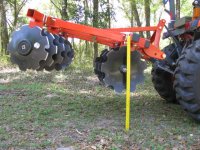 IMG_0591.JPG106.1 KB · Views: 805
IMG_0591.JPG106.1 KB · Views: 805 -
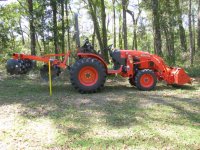 IMG_0590.JPG121 KB · Views: 447
IMG_0590.JPG121 KB · Views: 447 -
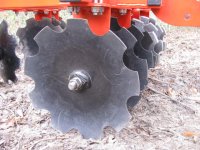 IMG_0555.JPG80.4 KB · Views: 348
IMG_0555.JPG80.4 KB · Views: 348 -
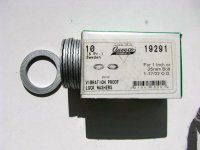 IMG_0564.JPG70.7 KB · Views: 324
IMG_0564.JPG70.7 KB · Views: 324 -
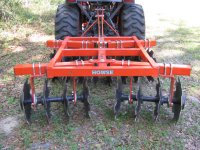 IMG_0592.JPG105.2 KB · Views: 607
IMG_0592.JPG105.2 KB · Views: 607 -
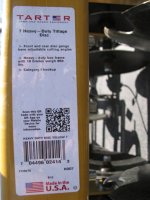 IMG_0595.JPG106.9 KB · Views: 324
IMG_0595.JPG106.9 KB · Views: 324 -
 IMG_0594.jpg119.1 KB · Views: 311
IMG_0594.jpg119.1 KB · Views: 311 -
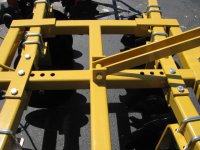 IMG_0596.jpg115.6 KB · Views: 475
IMG_0596.jpg115.6 KB · Views: 475 -
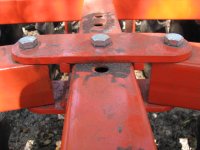 IMG_0566.JPG57.5 KB · Views: 277
IMG_0566.JPG57.5 KB · Views: 277 -
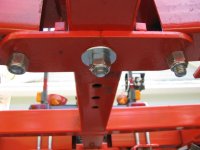 IMG_0589.JPG48 KB · Views: 245
IMG_0589.JPG48 KB · Views: 245 -
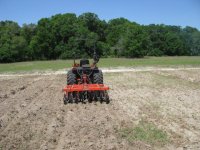 IMG_0630.JPG80.6 KB · Views: 883
IMG_0630.JPG80.6 KB · Views: 883 -
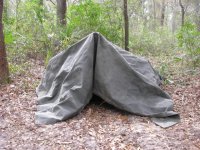 IMG_0581.JPG110.2 KB · Views: 281
IMG_0581.JPG110.2 KB · Views: 281 -
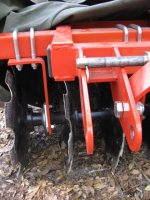 IMG_0597.jpg149.1 KB · Views: 434
IMG_0597.jpg149.1 KB · Views: 434
Last edited:
